Are you tired of dealing with uneven temperatures and high energy bills from your traditional HVAC system? Ductless cooling systems might be the solution you’ve been searching for. These systems are designed to provide efficient and customizable comfort for your home, without the need for bulky ductwork.
Ductless systems, often referred to as mini splits, are known for their energy efficiency. With SEER ratings higher than traditional systems, they can reduce your energy consumption by up to 30%, according to ENERGY STAR. This means significant savings on your monthly bills while keeping your home comfortable year-round.
One of the biggest advantages is their flexibility. Whether you’re retrofitting an older home or adding cooling to a new space, these systems are easy to install and maintain. Plus, they offer room-by-room temperature control, eliminating those pesky hot and cold spots.
Key Takeaways
- Ductless systems provide efficient and customizable comfort for your home.
- They can reduce energy consumption by up to 30%, saving you money.
- No ductwork is needed, making installation flexible and easy.
- Room-by-room temperature control eliminates uneven heating and cooling.
- These systems are ideal for both new constructions and retrofits.
Understanding Ductless Cooling Systems
Looking for a smarter way to cool your home without the hassle of ductwork? Ductless cooling systems are designed to provide efficient and customizable comfort for your home. These systems are perfect for spaces where traditional HVAC setups just don’t make sense.
Definition and Core Components
A ductless system, also known as a mini-split, consists of two main parts: an outdoor compressor and one or more indoor units. The outdoor unit houses the compressor and condenser, while the indoor units are mounted on walls or ceilings to distribute air directly into the room.
Unlike traditional systems, there’s no need for ductwork. This makes installation simpler and reduces energy loss. Each indoor unit operates independently, allowing you to control the temperature in specific areas of your home.
How They Differ from Traditional HVAC
Traditional HVAC systems rely on a network of ducts to circulate air. This can lead to energy loss through leaks and inefficient air distribution. Ductless systems, on the other hand, deliver air directly to each room, eliminating these issues.
Installation is another key difference. Traditional systems require extensive ductwork, which can be costly and invasive. Ductless systems only need a small hole in the wall to connect the indoor and outdoor units. This makes them ideal for older homes or new additions where ductwork isn’t feasible.
With a ductless system, you get room-by-room control, better energy efficiency, and improved air quality. It’s a modern solution for modern comfort needs.
How Does a Mini Split Heat Pump Work?
Ever wondered how a ductless system keeps your home perfectly comfortable year-round? The secret lies in its advanced technology and smart design. Unlike traditional systems, a ductless heat pump uses a combination of inverter technology and precise temperature regulation to deliver consistent comfort.
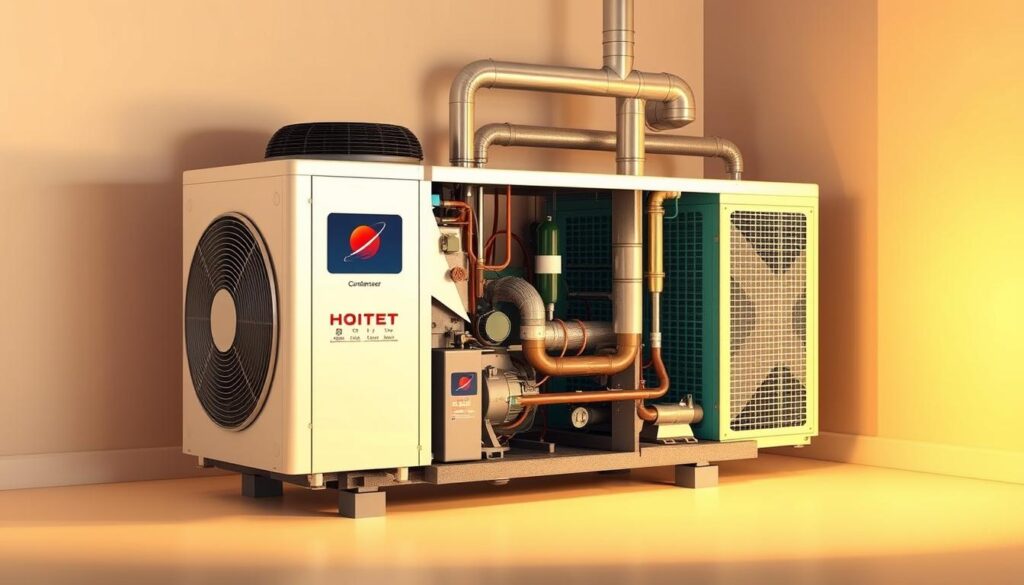
Inverter Technology Explained
At the heart of a ductless heat pump is inverter technology. Think of it as a smart thermostat on steroids. Instead of turning on and off like traditional systems, the inverter continuously adjusts the compressor’s speed. This means it uses only the energy needed to maintain your desired temperature, reducing energy waste.
Here’s how it works:
- The system monitors the room’s temperature using built-in sensors.
- It adjusts the compressor’s output to match the heating or cooling demand.
- This process eliminates energy spikes and keeps your home comfortable without sudden temperature swings.
Continuous Temperature Regulation in Action
Imagine your heat pump as a skilled chef, carefully adjusting the heat to cook a perfect meal. The system constantly monitors and fine-tunes the temperature in your home. If it detects a change, it adapts instantly, ensuring every room stays at the perfect comfort level.
This continuous regulation also improves energy efficiency. Studies show that ductless systems can use up to 60% less energy than traditional electric radiators. By delivering just the right amount of heat or cooling, they save energy and reduce your utility bills.
Whether it’s a chilly winter morning or a scorching summer afternoon, your ductless system works tirelessly to keep your home comfortable. It’s a modern solution for modern living.
Mini Split System Benefits for Enhanced Comfort
Want to enjoy consistent comfort in every room of your home? Ductless systems offer personalized temperature control, quiet operation, and effective dehumidification. These features make them a top choice for modern living.
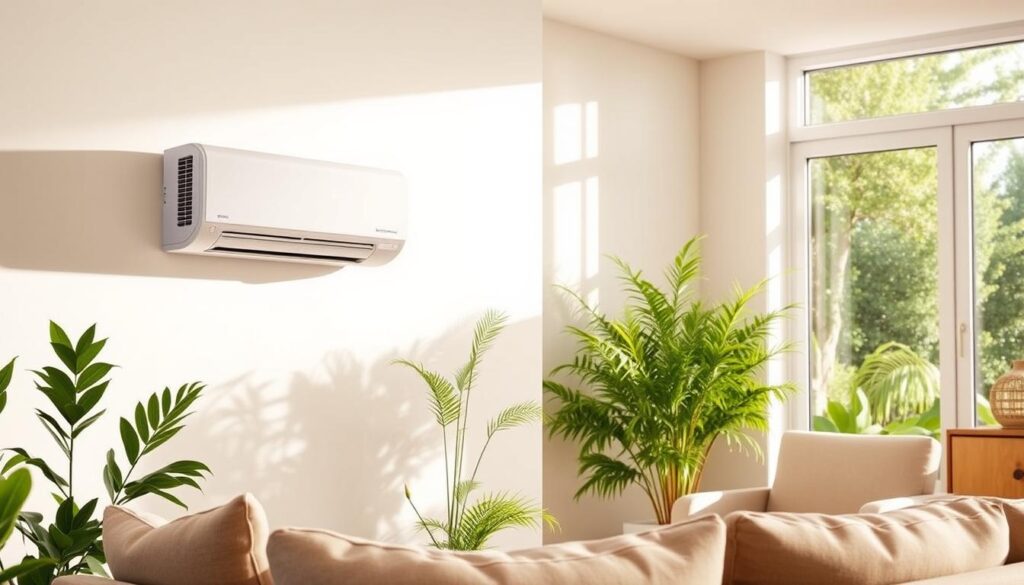
Personalized Temperature Control for Each Room
With a ductless system, you can set different temperatures for each room. This means no more arguing over the thermostat. Whether it’s a cozy bedroom or a sunny living area, you’re in full control of your comfort.
Traditional air conditioners rely on centralized ductwork, which often leads to uneven cooling. Ductless systems eliminate this issue by delivering air directly to each space. This ensures every corner of your home stays just the way you like it.
Quiet Operation and Effective Dehumidification
One of the standout features of ductless systems is their quiet operation. At sound levels as low as 19 dB, they’re quieter than a whisper. This makes them perfect for bedrooms, offices, or any space where peace and quiet matter.
These systems also excel at dehumidification. They remove moisture from the air continuously, improving comfort and air quality. This is especially helpful during humid summers or in damp areas like basements.
| Feature | Ductless System | Traditional Air Conditioner |
|---|---|---|
| Noise Level | 19 dB (Whisper Quiet) | 50-60 dB (Noticeable Noise) |
| Energy Efficiency | Up to 30% Savings | Lower Efficiency |
| Installation | Simple, No Ductwork | Complex, Requires Ductwork |
Whether it’s summer or winter, a ductless system keeps your home comfortable year-round. With efficiency, quiet operation, and precise control, it’s a smart upgrade for any home.
Energy Efficiency and Cost Savings of a Mini Split System
Are you looking to cut down on energy costs while maintaining a comfortable home? Ductless systems are designed to help you do just that. With their advanced technology and energy-efficient features, they offer a smart option for reducing your utility bills and improving your home’s comfort.
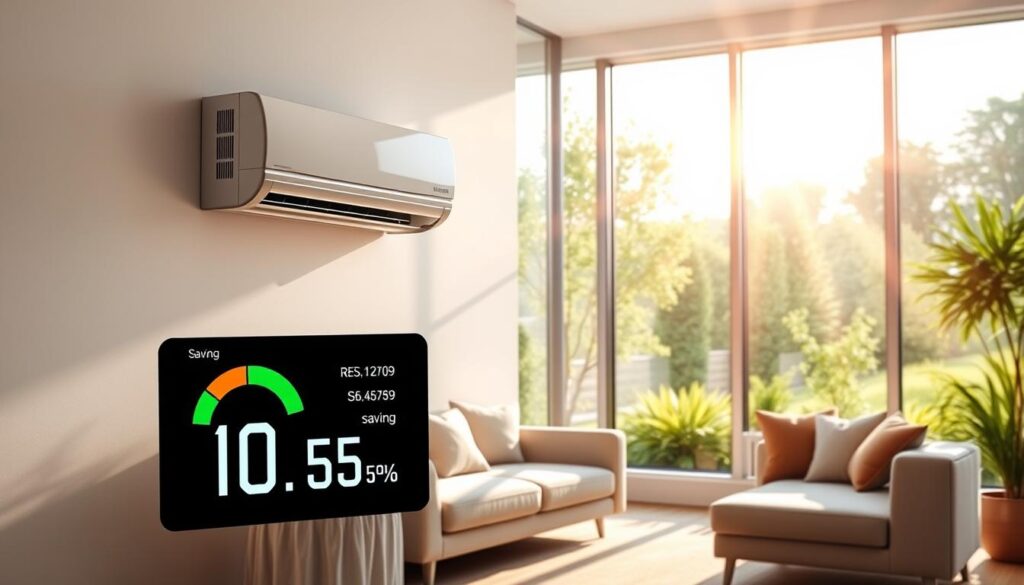
Achieving High SEER Ratings and Reduced Bills
One of the key factors that make ductless systems so efficient is their high SEER rating. SEER, or Seasonal Energy Efficiency Ratio, measures how well a system uses energy. The higher the SEER rating, the more energy-efficient the system.
Ductless systems often have SEER ratings of 20 or higher, compared to traditional systems that typically range between 13 and 16. This means they use less energy to work, saving you up to 30% on your monthly bills. For example, a study by the US Department of Energy found that ductless systems can reduce energy consumption by up to 34% in existing homes.
Leveraging Energy Rebates and Tax Benefits
Another way ductless systems save you money is through energy rebates and tax benefits. Many states offer rebates for installing ENERGY STAR-certified systems, which can offset the initial cost. Additionally, federal tax credits of up to $2,000 are available for qualifying systems installed between 2023 and 2032.
These incentives make ductless systems an even smarter option for homeowners. By taking advantage of these programs, you can reduce your upfront cost and enjoy long-term savings on your energy bills.
| Feature | Ductless System | Traditional HVAC |
|---|---|---|
| SEER Rating | 20+ | 13-16 |
| Energy Savings | Up to 30% | Lower Efficiency |
| Installation Cost | Lower (No Ductwork) | Higher (Ductwork Required) |
| Rebates Available | Yes | Limited |
Whether you’re looking to save money or reduce your carbon footprint, a ductless system is an intelligent option for your home. With high SEER ratings, energy rebates, and tax benefits, it’s a smart investment for long-term comfort and savings.
Your Comprehensive Mini Split Guide to Installation and Sizing
Ready to upgrade your home’s comfort with a ductless system but unsure where to start? Choosing the right equipment and ensuring proper installation can make all the difference. Let’s break it down step by step so you can make informed decisions for your space.
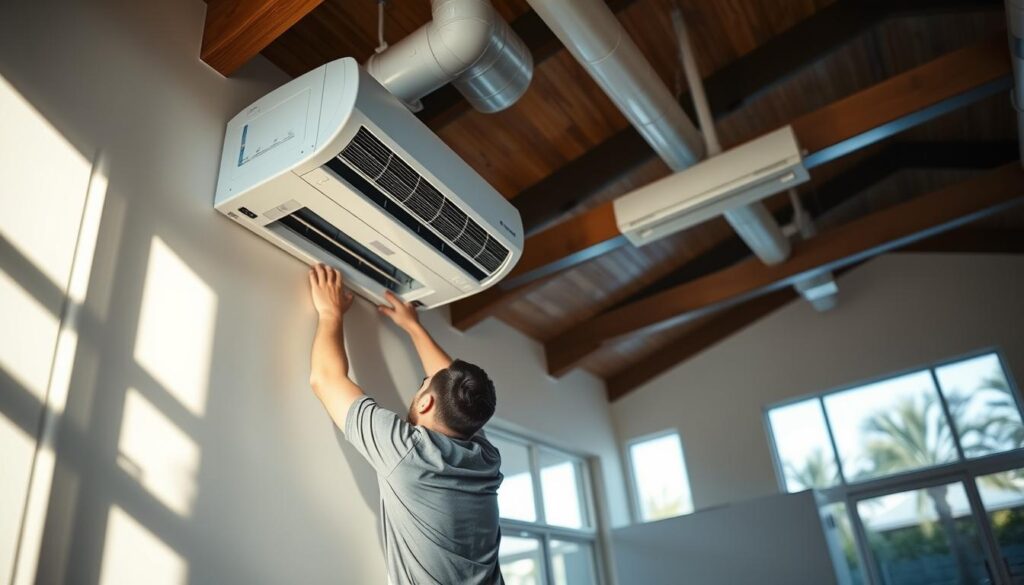
Assessing Your Home’s Layout
Start by evaluating your home’s layout. Measure each room to determine the square footage. This helps you choose the right unit size. For example, a 9,000 BTU unit can cool up to 450 square feet, while a 12,000 BTU unit handles up to 650 square feet.
Consider factors like ceiling height and insulation. Higher ceilings or poor insulation may require a larger unit. Proper sizing ensures efficient cooling and avoids unnecessary energy costs.
Precise Installation and Line Set Routing
Proper installation is crucial for optimal performance. Ensure the indoor unit is mounted 8-9 feet from the floor with at least 6 inches of clearance on all sides. The outdoor condenser should have 1 foot of space to the left and rear, 20 inches to the right and top, and 6.5 feet of open space in front.
When routing the line set, drill a 2 to 2.5-inch hole at a 5-10 degree downward angle. This prevents water from entering your home. A well-installed line set ensures smooth operation and longevity.
Determining Cooling and Heating Needs
Use a sizing calculator to determine your space’s BTU requirements. For example, a well-insulated room needs about 25 BTU per square foot for cooling. Poor insulation may require up to 40 BTU per square foot.
Don’t forget to factor in additional heat sources, like appliances or sunlight. Oversizing your unit can lead to energy waste, while undersizing won’t meet your comfort needs.
Avoiding Common Mistakes
One common mistake is neglecting to evacuate the line set properly. Use a vacuum pump rated at 3-5 CFM to remove air and moisture. This step ensures efficient operation and prevents damage to the system.
Another error is improper placement of the indoor unit. Avoid mounting it near heat sources or in direct sunlight. This ensures accurate temperature readings and consistent comfort.
| Feature | Recommendation |
|---|---|
| Indoor Unit Height | 8-9 feet from the floor |
| Line Set Hole Size | 2 to 2.5 inches |
| BTU per Square Foot | 25-40 (based on insulation) |
| Clearance for Condenser | 1 foot left/rear, 20 inches right/top |
By following these tips, you can ensure a smooth installation and enjoy the full benefits of your ductless system. Take your time, measure carefully, and don’t hesitate to seek professional help if needed. Your comfort is worth it!
Installation Tips and Essential Mini Split Accessories
Thinking about upgrading your home’s cooling system but unsure where to begin? Installing a ductless system doesn’t have to be overwhelming. With the right guidance and tools, you can ensure a smooth setup that maximizes comfort and efficiency.
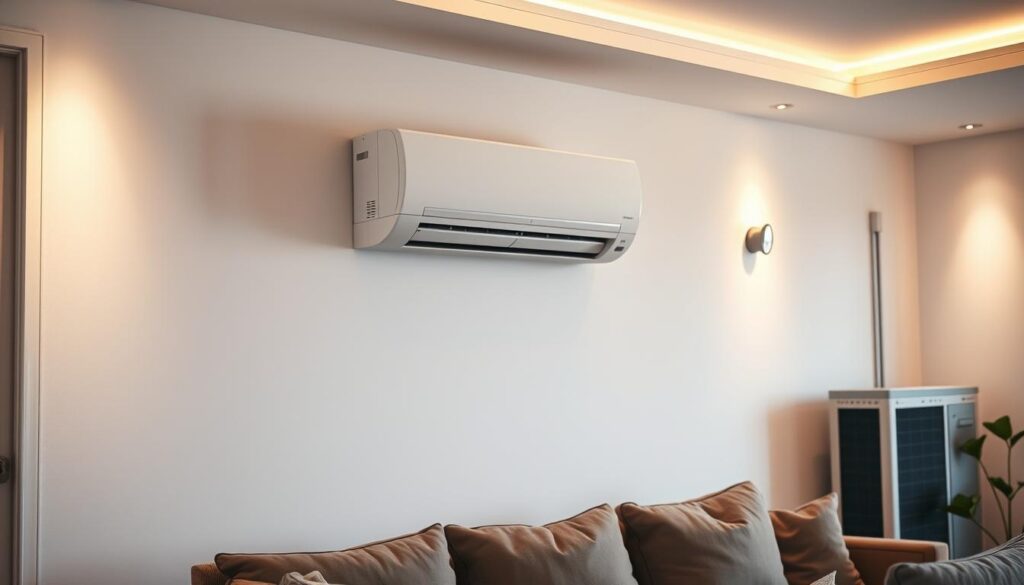
Step-by-Step Installation Insights
Start by choosing the right location for your indoor and outdoor units. For the indoor unit, mount it on a wall or ceiling at least 7 feet from the floor. This ensures optimal air distribution. The outdoor unit should be placed on a stable surface, like a condenser pad, and have at least 1 foot of clearance on all sides.
Next, drill a small hole in the wall to connect the indoor and outdoor units. Use a high-quality sealant to prevent air leaks and pest entry. Properly insulate the refrigerant lines to minimize energy loss and protect against damage.
Finally, test the system to ensure it’s working correctly. A thorough pressure check using nitrogen can help detect any leaks. If you’re not confident in your DIY skills, consider hiring a professional HVAC contractor for the job.
Must-Have Accessories for Optimal Performance
To get the most out of your system, invest in essential accessories. Line sets are crucial for connecting the indoor and outdoor units. Choose high-quality, pre-insulated lines to reduce energy loss.
Condensate pumps are another must-have. They help drain water produced during heating or cooling, preventing moisture buildup. For added safety, install a quick disconnect switch, which is required by many building codes.
Don’t forget about surge protectors. They divert extra voltage to the ground, protecting your system from power surges. Brands like GREE offer reliable accessories designed specifically for their systems.
By following these tips and using the right accessories, you can ensure a hassle-free installation and enjoy the full benefits of your ductless system. Take your time, measure carefully, and don’t hesitate to seek professional help if needed. Your comfort is worth it!
Navigating Single-Zone and Multi-Zone Configurations
Struggling to decide between a single-zone or multi-zone setup for your home? Understanding the differences can help you choose the right configuration for your needs. Whether you’re looking to cool a single room or multiple spaces, each option has its unique benefits.
Advantages of Single-Zone Systems
A single-zone system is perfect for targeted cooling or heating. It connects one indoor unit to one outdoor unit, making it ideal for smaller spaces like a home office or guest room. These systems are simple to install and often have lower upfront costs compared to multi-zone setups.
For example, if you only need to cool a single room, a single-zone system is a cost-effective solution. It’s also energy-efficient since it only operates in the area you’re using. This makes it a great choice for those who don’t need whole-house cooling.
The Flexibility of Multi-Zone Designs
On the other hand, a multi-zone system offers greater flexibility. It connects one outdoor unit to multiple indoor units, allowing you to control the temperature in different rooms independently. This is perfect for larger homes or households with varying comfort preferences.
With a multi-zone setup, you can cool your living room while keeping the bedroom warmer. This personalized control not only enhances comfort but also improves energy efficiency. Studies show that multi-zone systems can save up to 40% more energy than traditional HVAC systems.
For instance, a family with different schedules can benefit from a multi-zone system. While one person prefers a cooler bedroom at night, another might want a warm kitchen in the morning. This flexibility ensures everyone stays comfortable without wasting energy.
Choosing between a single-zone and multi-zone system depends on your specific needs. If you’re cooling a single room, a single-zone system is a practical choice. For larger spaces or personalized comfort, a multi-zone setup is worth considering. Both options offer energy efficiency and improved comfort, making them a smart upgrade for any home.
Overcoming Weather Challenges and Electrical Considerations
Worried about how your cooling system will handle extreme weather or electrical demands? Ductless systems are designed to perform efficiently in various conditions, but proper preparation is key. Let’s explore how to tackle these challenges and ensure your system runs smoothly year-round.
Preparing for Extreme Climates
Extreme weather can impact the efficiency of your system. In freezing temperatures, the outdoor unit may struggle to extract heat from the air. Similarly, scorching heat can strain the system’s cooling capacity. To combat this, consider these tips:
- Install a wall-mounted or floor unit in areas less exposed to direct sunlight or cold drafts.
- Use weatherproof covers for the outdoor unit during harsh winters to prevent ice buildup.
- Schedule regular maintenance to ensure the system is in peak condition before extreme weather hits.
Proper insulation and strategic placement of indoor units can also help maintain consistent heating cooling performance, even in challenging climates.
Understanding Electrical Requirements
Your system’s efficiency depends on the right electrical setup. Most ductless systems require a 208-230 Volt service, which may differ from your home’s current wiring. Here’s what to keep in mind:
- Hire a licensed electrician to assess your home’s electrical capacity and make necessary upgrades.
- Ensure the circuit breaker matches the system’s requirements to avoid overloading.
- Use surge protectors to safeguard your system from power fluctuations during storms.
By addressing these electrical considerations, you can ensure your system operates safely and efficiently, even during extreme weather events.
Whether it’s a freezing winter or a scorching summer, proper preparation and understanding of your system’s needs can make all the difference. Take these steps to enjoy reliable heating cooling year-round.
Optimizing Indoor Comfort and Air Quality
Looking to breathe cleaner air and boost your home’s comfort levels? Your air conditioning system plays a vital role in maintaining a healthy indoor environment. With the right steps, you can enhance air quality and enjoy a fresher, more comfortable living space.
Enhancing Air Filtration and Purification
One of the easiest ways to improve air quality is by upgrading your conditioner’s filtration system. High-efficiency filters can trap dust, pollen, and allergens, keeping the air in your home cleaner. Regularly replacing these filters every 1-3 months ensures optimal airflow and efficiency.
If you’re using a ductless system, you’re already at an advantage. These systems feature independent air filtration units in each indoor module. This means every room benefits from its own purification process, reducing the spread of pollutants throughout your home.
Another advantage of ductless systems is their ability to dehumidify continuously. By removing excess moisture from the air, they prevent mold growth and create a more comfortable environment. This is especially helpful during humid summers or in damp areas like basements.
Complementing Your Existing Air Conditioning
Ductless systems can work alongside your traditional air conditioning setup to provide cleaner air. For example, you can use a ductless unit in a room that needs extra filtration or dehumidification. This targeted approach ensures every corner of your home stays fresh and comfortable.
Independent control over each unit is another key benefit. You can adjust the temperature and airflow in specific rooms, tailoring the environment to your needs. This flexibility not only enhances comfort but also improves energy efficiency by avoiding unnecessary cooling or heating.
Practical Tips for Better Air Quality
- Schedule annual maintenance to keep your system running smoothly.
- Invest in programmable thermostats to optimize temperature settings.
- Seal gaps around windows and doors to prevent drafts and energy loss.
- Monitor humidity levels and use a dehumidifier if needed.
By following these tips, you can transform your home into a haven of clean, comfortable air. Whether you’re upgrading your conditioner or adding a ductless system, these steps ensure you breathe easier and live better.
Conclusion
Ready to transform your home’s comfort and efficiency? Ductless systems offer a modern solution for personalized climate control, energy savings, and flexibility. Whether you’re upgrading a single room or your entire home, these systems provide year-round benefits without the hassle of ductwork.
For smaller projects, DIY installation can be straightforward, but larger setups often benefit from professional expertise. Consulting with an HVAC specialist ensures your system is tailored to your home’s unique needs.
Take the next step today. Explore your options, weigh the benefits, and consider how a ductless system can enhance your living space. Your home deserves the best in comfort and efficiency—start your journey now!
FAQ
What is a ductless cooling system, and how does it work?
How does a mini-split system differ from traditional HVAC systems?
What are the benefits of inverter technology in a heat pump?
Can a mini-split system save me money on energy bills?
How do I choose the right size system for my home?
What’s the difference between single-zone and multi-zone configurations?
Can a mini-split system handle extreme weather conditions?
What accessories can enhance my mini-split system’s performance?
How does a mini-split system improve indoor air quality?
Are there any rebates or tax benefits for installing a mini-split system?
Source Links
- Mini split AC guide: How do mini splits work?
- Ductless Mini-Splits: A Complete Guide To Cost, Benefits, And Installation
- Ductless Mini-Split Air Conditioners
- Ductless HVAC Guide: Mini-Split Benefits, Options & More
- Ductless Mini Splits: All You Need to Know
- Ductless Mini Split – How Ductless HVAC Systems Work – Trane®
- What is a Mini-Split | A Guide to Ductless Heat Pumps
- How Do Ductless Mini-Split Heat Pumps Work?
- The Ultimate Pros & Cons of Mini-Split Systems – ICS HVAC
- Ductless Mini-Split Systems: A Comprehensive Guide
- Comprehensive Guide to Ductless Mini Split Systems
- The Cost of Ductless Mini-Splits: Your Comprehensive Guide | GREE Comfort
- Ductless Heating & Cooling
- Comprehensive Guide to Mini-Split Systems – Mountaineer Heating & Cooling
- DIY Mini Split Installation – A Complete A to Z Detailed Guide – LRN2DIY
- Sizing Guide for a Mini Split Air Conditioner
- Comprehensive Guide to Sizing a Mini Split Heat Pump: Helpful Tips
- Your Guide to Mini-Split Accessories for Installations | GREE Comfort
- How to Properly Install a Ductless Mini-Split System
- Tips for Mini-Split Installation Success
- Single-Zone vs Multi-Zone Ductless Mini Splits: Unveiling the Ultimate Heating & Cooling Showdown!
- HVAC Zoning Explained: Single- vs. Multi-Zone Systems
- Microsoft PowerPoint – BOS22-212 Overcoming Barriers to Heat Pumps
- Overcoming November Heating Challenges and How AC Direct Addresses Your Furnace Needs
- A Breath of Fresh Air: Your Comprehensive Guide to Mastering Residential HVAC Systems for Optimal Comfort and Efficiency – Majestic Air Conditoning
- Enhance Indoor Air Quality with Mini-Split Systems
- Mini Split Pros and Cons: Ultimate Homeowner’s Guide – Blue Ridge Heating & Air
- The Ultimate Guide to Mini Split Systems: Everything You Need to Know

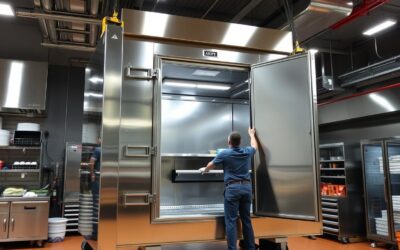
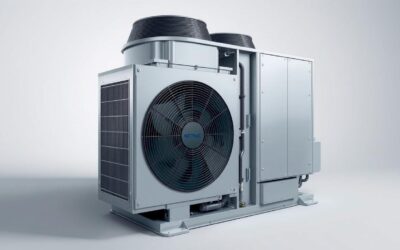
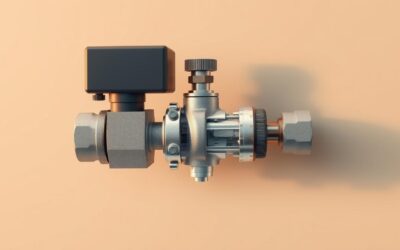
0 Comments